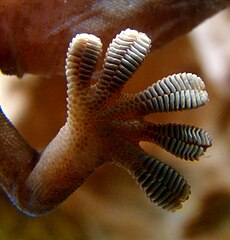18 April 2014. Materials scientists and biologists at University of Massachusetts in Amherst developed an adhesive technology that attaches heavy loads to a variety of surfaces, yet can still be easily removed and reused. The journal Advanced Materials published yesterday online the work of the team led by polymer scientist Alfred Crosby (paid subscription required).
To create the technology, the UMass team emulated the adhesive properties of feet found on the Tokay gecko, a reptile found in Southeast Asia and Australia. The gecko’s feet have fine, yet stiff bristles that are integrated with the skin, tendons, and bones to enable the reptile to adhere to vertical and overhanging surfaces, yet quickly release from those surfaces when necessary.
Crosby and colleagues designed the adhesive, called Geckskin, to use draping adhesion, where the adhering material conforms to the target surface, while maintaining a high, elastic stiffness in directions where force is applied. This method more evenly distributes the load across the surface area of the adhering pad, yet it still can be easily detached without leaving a residue.
Geckskin, say its inventors, uses Kevlar or carbon fiber to provide the stiffness on the skin, combined with soft elastomers — polymers with elastic properties — such as polyurethane on the pad. The materials used in Geckskin are off-the-shelf commodities, not those created through complex processes, such as nanotechnology.
In earlier versions of Geckskin, the researchers showed it could adhere to smooth surfaces, such as glass. For its latest iteration, the researchers were able to fine-tune the relative stiffness of the materials making it possible to adhere to more types of common materials, including drywall and wood.
In their Advanced Materials paper, Crosby and colleagues tested the adhesive with three types of everyday materials, to emulate the adhesive force of the Tokay gecko. The researchers report the results showed the new Geckskin could adhere to these surfaces with forces that exceeded those of the gecko.
The university has a patent pending on the invention and offers the technology for licensing.
In the following video (7 minutes), co-inventors Mike Bartlett and Daniel King demonstrate Geckskin to attach and remove a display monitor from a number of indoor and outdoor surfaces, and appear to enjoy every minute of it.
- Artificial Muscle Created from Fishing Line, Thread Material
- Metal-Organic Framework Developed that Responds to UV Light
- Heart Vessel Surgical Glue Shown Effective in Animal Tests
- Small-Scale Ceramics Materials Engineered for Flexibility
- University of Houston Spins-Off Nanotech Coatings Company
* * *


 RSS - Posts
RSS - Posts